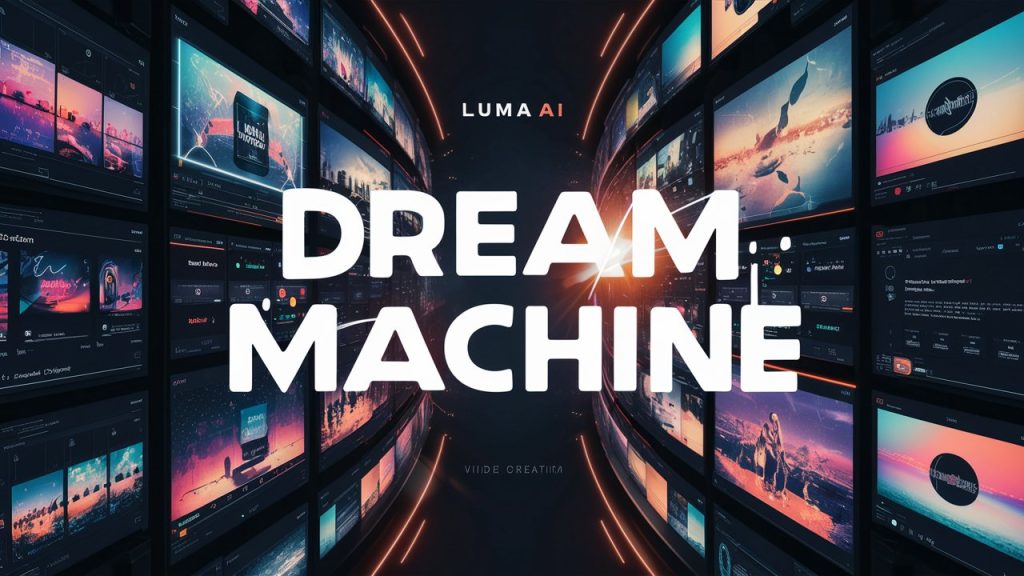Luma AI, a leading innovator in artificial intelligence, has introduced its latest creation, the Dream Machine. This groundbreaking AI video creation tool is set to revolutionize the industry, offering a seamless blend of advanced technology and user-friendly features.
Luma AI has introduced the Dream Machine, an advanced AI tool designed to revolutionize video creation. Leveraging state-of-the-art generative AI, the Dream Machine aims to provide users with the ability to create high-quality, realistic videos from text prompts. This positions it as a direct competitor to other prominent AI video tools like OpenAI’s Sora and Runway ML.
Key Features of Dream Machine
Luma AI’s Dream Machine stands out due to several innovative features:
- Text-to-Video Generation: Users can generate detailed and realistic videos from textual descriptions.
- High Fidelity and Realism: The Dream Machine excels in producing videos that are visually stunning and lifelike.
- User-Friendly Interface: Designed for both novices and professionals, the interface is intuitive and easy to navigate.
- Speed and Efficiency: The Dream Machine can generate videos quickly, making it suitable for various applications, from social media content to professional film production.
Pricing
Luma AI offers several pricing plans for the Dream Machine:
- Free: 30 generations per month
- Standard: $29.99 for 120 generations per month
- Pro: $99.99 for 400 generations per month
- Premier: $499.99 for 2,000 generations per month
Competitive Analysis of Dream Machine
In the competitive landscape of AI video creation, the Dream Machine stands out against rivals like Sora and OpenAI’s tools. Its unique selling points include a user-friendly design and a comprehensive feature set that cater to a wide range of users. Unlike its competitors, the Dream Machine offers advanced capabilities without compromising on ease of use.
Just like there are multiple AI music generators in the market same way there is now a variety of text-to-video generators out there and here Luma AI’s Dream Machine enters a competitive market, facing off against notable players like OpenAI’s Sora and Runway ML. Here’s how it compares:
- OpenAI’s Sora:

- Strengths: Sora is known for its ability to create highly imaginative and realistic videos from text prompts. It utilizes a diffusion model, starting with noise and refining it to create detailed videos. Sora’s foundation on the technology behind DALL·E 3 gives it a robust capability in generating diverse and high-quality visual content.
- Limitations: Currently, Sora is in a testing phase and not widely available. It primarily accepts text inputs and has yet to disclose its pricing structure.
- Runway ML:

- Strengths: Runway ML offers a comprehensive suite of AI tools for content creation, including text-to-image, video-to-video, and motion brush tools. It is highly versatile, supporting various input modalities and providing extensive capabilities for video editing and transformation.
- Limitations: While versatile, Runway ML may require a steeper learning curve due to its wide range of tools. It operates on a subscription-based model, which might be a consideration for budget-conscious users.
- Google and Meta’s Tools:
- Strengths: Both tech giants have demonstrated strong capabilities in AI video generation, with significant resources dedicated to research and development.
- Limitations: The offerings from Google and Meta are typically integrated into larger ecosystems, which might limit their standalone usability and accessibility.
Luma AI’s Dream Machine aims to bridge the gap by offering high-quality video generation with a user-friendly interface and rapid processing capabilities, potentially positioning it as a preferred choice for both individual creators and professional studios.
Technology Behind the Dream Machine
At the heart of the Dream Machine lies a combination of sophisticated AI algorithms and deep learning models. These technologies enable the tool to generate and edit video content efficiently.
For instance, users can describe a scene, and the Dream Machine will generate a corresponding video segment. This integration of advanced AI technologies ensures a seamless and high-quality output.
My Experience of Dream Machine
My personal experience with the Dream Machine has been a mix of awe and frustration. I tested the tool by providing some prompts and images. The results were phenomenal in terms of creativity and execution, but I encountered issues with motion consistency and dysmorphia.
One of the key challenges observed with Dream Machine is inconsistency in motion and the occurrence of dysmorphia, especially in dynamic scenes involving human figures.

For instance, I uploaded an image of Jawaharlal Nehru and Mahatma Gandhi, and prompted the machine to
Make them both crack jokes.
While the Dream Machine successfully animated them laughing, the hand motions were dysmorphic and unnatural. This issue of dysmorphia in motion can detract from the overall quality and realism of the output.
In another instance, I provided a prompt that described
A teen boy in the night in a jungle finding an old book with the name ‘Shiva’ written over it.”
Unfortunately, the Dream Machine failed to render the name ‘Shiva’ on the book, indicating weaknesses in text and typography integration. This indicates a significant area for improvement in the AI’s ability to integrate and render textual elements seamlessly within video contexts.
Recommendations for Improvement
- Enhanced Motion Algorithms: Improving the algorithms that handle motion and human figures could significantly reduce instances of dysmorphia. This involves refining the neural networks to better understand and replicate natural human movements, ensuring smoother and more realistic motion in the generated videos.
- Text Rendering Capabilities: Enhancing the AI’s capability to accurately render text within videos is crucial. This could involve training the AI on a diverse set of text-integration scenarios, ensuring it can handle various fonts, sizes, and placements effectively.
- User Feedback Integration: Actively integrating user feedback into the development cycle can help identify common issues and areas for improvement. This iterative approach allows the AI to evolve based on real-world use cases and user experiences.
Expert Recommendations for Luma AI’s Dream Machine
To maximize the potential of Luma AI’s Dream Machine, here are some expert recommendations based on the insights from the videos and additional research:
- Integrate Ethical Frameworks: Implement ethical AI frameworks like TAI to ensure that the Dream Machine adheres to high standards of transparency and accountability. This will enhance trust and reliability in AI-generated videos.
- Adopt Data-Centric Practices: Prioritize data quality and clarity over algorithmic complexity. Use tools like DVC and nbdev to manage data and documentation effectively, ensuring traceability and integrity.
- Leverage GitOps for CI/CD: Utilize GitOps to automate the development pipeline, from code to deployment. This approach will help maintain continuous quality and integrate ethical checks seamlessly, ensuring that the Dream Machine operates ethically and efficiently.
By following these recommendations, developers can ensure that Luma AI’s Dream Machine not only pushes the boundaries of AI video creation but also upholds the highest standards of ethical and technical excellence.
Conclusion
Luma AI’s Dream Machine is poised to transform the landscape of AI video creation. With its advanced features, user-friendly design, and competitive edge, it offers a powerful solution for anyone looking to create high-quality videos with ease.
Whether you’re a professional filmmaker or a casual content creator, the Dream Machine is set to become an essential tool in your arsenal.






